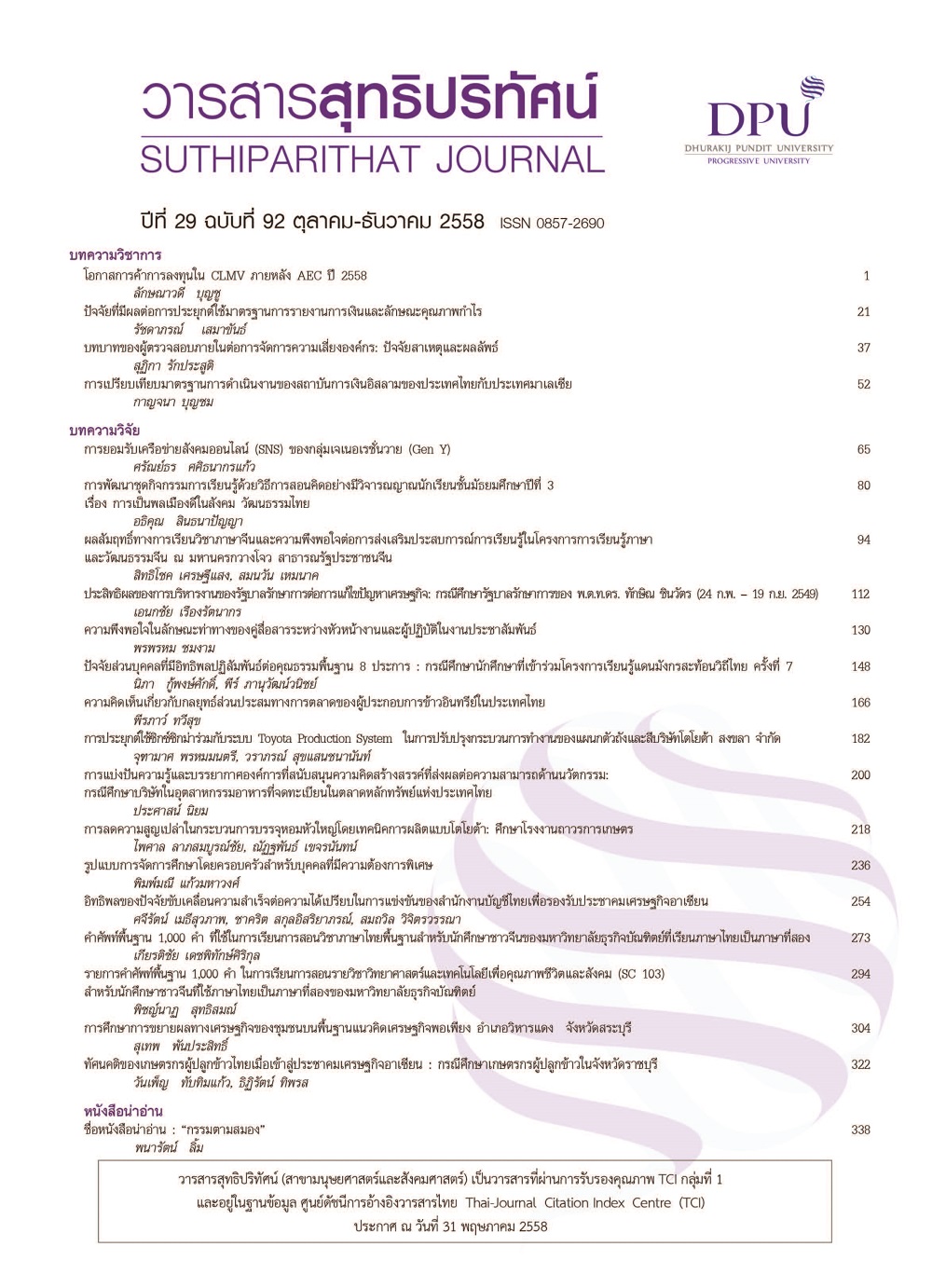ความคิดเห็นเกี่ยวกับกลยุทธ์ส่วนประสมทางการตลาดของผู้ประกอบการข้าวอินทรีย์ในประเทศไทย
คำสำคัญ:
กลยุทธ์ส่วนประสมทางการตลาด, ผู้ประกอบการ, ข้าวอินทรีย์บทคัดย่อ
การศึกษาครั้งนี้เป็นงานวิจัยเชิงคุณภาพโดยมีแบบสัมภาษณ์เป็นเครื่องมือในการวิจัย ทั้งนี้ ผู้วิจัยได้เก็บหน่วยตัวอย่างผู้ประกอบการข้าวอินทรีย์จำนวน 13 ราย จากทั้ง 6 ภาคทั่วประเทศไทย ผลจากการสัมภาษณ์ความคิดเห็นในส่วนของการกำหนดกลยุทธ์ด้านสินค้าของผู้ประกอบการข้าวอินทรีย์ในภาคเหนือ ภาคตะวันออกเฉียงเหนือและภาคตะวันออกให้ความสำคัญกับการที่สินค้าจะต้องมีใบรับรองมาตรฐานคุณภาพสินค้า ผู้ประกอบการในภาคกลางและตะวันตกให้ความสำคัญกับการสร้างตราสินค้าและผู้ประกอบการในภาคใต้ให้ความสำคัญกับการเปิดเผยข้อมูลที่โปร่งใส
ต่อมาผลจากการสัมภาษณ์ความคิดเห็นในส่วนของการกำหนดกลยุทธ์ด้านราคาของผู้ประกอบการข้าวอินทรีย์ในภาคเหนือและภาคตะวันออกมีความคิดเห็นในเรื่องของราคาขาย 2 ความคิดเห็นคือ 1) มีความคิดเห็นว่าราคาขายข้าวอินทรีย์น่าจะสูงกว่าข้าวทั่วไป โดยราคาขายข้าวอินทรีย์ควรสูงกว่าสินค้าทั่วไปและ 2) ราคาขายข้าวอินทรีย์ควรมีความใกล้เคียงกับข้าวทั่วไป เพราะจะทำให้สินค้าเป็นที่รู้จักและง่ายแก่การขาย สำหรับภาคกลาง ภาคตะวันออกเฉียงเหนือ ภาคตะวันตกและใต้ ผู้ประกอบการมีความคิดเห็นในการกำหนดราคาขายเหมือนกันคือราคาขายข้าวอินทรีย์ควรมีราคาใกล้เคียงกับข้าวทั่วไป
สำหรับความคิดเห็นในส่วนของการกำหนดกลยุทธ์ด้านช่องทางการกระจายสินค้าของผู้ประกอบการข้าวอินทรีย์ในภาคเหนือ ภาคตะวันออกเฉียงเหนือ ภาคกลาง ภาคตะวันออกและ ภาคตะวันตกให้ความสนใจช่องทางการขายสินค้าผ่านซุปเปอร์มาร์เก็ต เช่น ท๊อปซุปเปอร์มาร์เก็ต วิลล่ามาร์เก็ตและฟู้ดแลนด์ เป็นต้นและสำหรับผู้ประกอบการในภาคใต้ให้ความสนใจกับการกระจายสินค้าผ่านระบบสมาชิก เช่น สหกรณ์
และสุดท้ายความคิดเห็นในส่วนของการกำหนดกลยุทธ์การส่งเสริมการตลาดผู้ประกอบการข้าวอินทรีย์ในภาคเหนือ ภาคตะวันออกเฉียงเหนือ ภาคกลาง ภาคตะวันออกและภาคตะวันตก ให้ความสนใจกับการใช้เวบไซด์หรือเวบเพจในการสื่อสารหรือติดต่อกับลูกค้า และผู้ประกอบการข้าวอินทรีย์ในภาคใต้ให้ความสนใจกับการจัดทำบัตรสมาชิก
เอกสารอ้างอิง
กรีนเน็ท (2557) 10 ตุลาคม 2557 http://www.greennet.or.th/article/1009
ธีรพันธ์ โล่ห์ทองคำ.(2544). Strategic IMC กลยุทธ์สื่อสารการตลาดแบบครบวงจร. Tipping Point Press.
สมาคมการค้าเกษตรอินทรีย์ (2557) 14 ตุลาคม 2557 http://www.thaiorganictrade.com/
Benjamin, M. O., William, K. H., & Anne, C. B. (2007). Purchasing organic food in US food systems; A study of attitudes and practice. British Food Journal Bradford, 109, 399.
Blackwell, R. D., Miniard, P. W., & Engel, F. J. (2002). Consumer Behavior. Singapore: Thomson Learning Inc.
Chen, M. (2007). Consumer attitudes and purchase intentions in relation to organic foods in Taiwan moderating effects of food-related personality traits. Food Quality and Preference, 18, 10-21.
Choo, H., Chung, J. E., & Pysarchi, D. T. (2004). Antecedents to new food product purchasing behavior among innovator groups in India. European Journal of Marketing, 38, 608-662.
Claro, P. D., & Borin, P. (2004). Coordinating B2B cross-border supply chains: the case of the organic coffee industry. The Journal of Business and Industrial Marketing Santa Barbara, 19, 405.
Creswell, J. (1998). Qualitative inquiry and research design (5 Ed.). Thousand Oaks: CA : Sage.
DeBoer, J. (2003). Sustainability labelling schemes: the logic of their claims and their functions for stakeholders. Business Strategy and the Environment,, 12, 254-264.
Delmas, M. A., & Burbano, V. C. (2011). The drivers of green washing. California Management Review, 54(1), 64-87.
Dimitri, C., & Greene, C. (2002). Recent Growth Patterns in the U.S. Organic Foods Market.Economic Research Service Agriculture Information. (Master of Business Administration), Washington DC, United States.
Dreezens, E., Martijn, C., Tenbult, P., Kok, G., Vries, D., & Nanne, K. (2008). The Missing Link: On Strengthening the Relationship Between Values and Attitudes. Basic & Applied Social Psychology, 30, 142-152.
Gemma, C. H., & Aikaterini, M. (2002). Consumer perception of organic food production and farm animal welfare. British Food Journal Bradford, 104, 287.
Gemma, E. (2009). Social Movements.Habermas and Social Movement Theory. Manchester University.
Ginsberg, M., & Bloom, P. N. (2004). Choosing the right green marketing strategy. Management Review, 46(1), 79-84.
Grannis, J., & Thilmang, D. D. (2002). Marketing Natural pock An empirical analysis of consumer in the Mountain Region. Agribusiness, 18, 475-489.
Hamzaoui, E. L., & Mehdi, Z. (2008). Decision making process of community organic food consumers an exploratory study. Journal of Consumer Marketing, 25, 95-104.
Hee, Y. K., & Chung, E. J. (2011). Consumer purchase intention for organic personal care products. Journal of Consumer Marketing, 28, 40-47.
Hill, H., & Lynchehaun, F. (2002). Organic milk: attitudes and consumption patterns. British Food Journal,, 104, 526-542.
Howard, H. P., & Patricia, A. (2006). Beyond organic : consumer interest in new labeling schemes in the central coast of California. International Journal of Consumer Studies,, 30, 439-451.
Hughner, S. R., Pierre, M., Prothero, A., Shultz, J. C., & Stanton, J. (2007). Who are organic food consumers? A compilation and review of why people purchase organic food. Journal of Consumer Behaviour, 6, 94.
Kahneman, D., & Tversky, A. (1979). Prospect Theory: An Analysis of Decision under Risk. The Econometric Society, 47, 263-292.
Kotler, P. (2000). Marketing Management Millenium Edition. New Jersey: Prentice-Hall.
Kotler, P., & Keller, K. L. (2006). Marketing Management. (12 ed.). NJ: Publication Upper Saddle River Pearson Prentice Hall.
Krystallis, A., & Chryssohoidis, G. (2005). Consumers willingness to pay for organic food: Factors that affect it and variation per organic product type. British Food Journal, 107, 320-343.
Lohr, L., & Park, T. (1999). Integrated markup rules for optimal pricing decisions in expanding markets for organic produce. London Applied Economics, 31, 885.
Mahapatra, S. N., Kumer, J., & Chauhan, A. (2010). Consumer Satisfaction, Dissatisfaction and Post-Purchase Evaluation : An Empirical study on small size passenger cars in India. International Journal of Business and Society, 11, 97-108.
McEachern, M. G., & McClean. (2002). Organic Purchasing motivation and attitudes : are they ethical? International Journal of Consumer Studies Oxford, 26, 85-92.
Miles, M. P., & Covin, J. G. (2000). Environmental marketing : a source of reputational, competitive, and financial advantage. Journal of Business Ethics, 23, 299-311.
Moore, O. (2006). Understanding postorganic fresh fruit and vegetable consumers at participatory farmers’ markets in Ireland: reflexivity, trust and social movements. International Journal of Consumer Studies Oxford, 30, 416.
Pamela, W., Benton, L., Warmerdam, J., & Sheehan, P. (2002). Comparative of organic and conventional fresh product Consumers in the Boston Area. Society for Risk Analysis, 20, 735-746.
Rajagopal, A. (2007). Buying decision towards organic product : an analysis of customer value and brand drivers. International Journal of Emerging Markets, 2(3), 236-251.
Reinhardt, F. L. (1998). Environmental product differentiation: implications for corporate strategy. California Management Review, 40(4), 43-73.
Rowley, J., & Marco. (2006). SpieziaOrganic : an SME Marketing Case Study. The Marketing Review, 6, 253-236.
Semenik, R. J. (2002). Promotion and Integrated Marketing Communication. Ohio South-Western.
Somnath, C., & Baisya, K. R. (2009). The influences of consumer innovativeness and consumer evaluation attributes in the purchase of fashionable ethnic wear in India International Journal of Consumer Studies Oxford, 33, 706.
Squires, L., Juric, B., & Cornwell, B. T. (2001). Level of market development and intensity of organic food consumption: Cross-cultural study of Danish and New Zealand consumers. The Journal of Consumer Marketing Santa Barbara, 18, 392.
Tarkiainen, A., & Sundqvist, S. (2005). Subjective norms, attitudes and intentions of Finnish consumers in buying Organic Food. British Food Journal, 107, 808-822.
Zepeda, L., & Jinghan, L. (2007,). Characteristics of Organic Food Shoppers. Journal of Agricultural and Applied Economics Athens, 39, 17.
ดาวน์โหลด
เผยแพร่แล้ว
รูปแบบการอ้างอิง
ฉบับ
ประเภทบทความ
สัญญาอนุญาต
เนื้อหาและข้อมูลในบทความที่ลงตีพิมพ์ในวารสารสุทธิปริทัศน์ ถือเป็นข้อคิดเห็นและความรับผิดชอบของผู้เขียนบทความโดยตรงซึ่งกองบรรณาธิการวารสาร ไม่จำเป็นต้องเห็นด้วย หรือร่วมรับผิดชอบใด ๆ
บทความ ข้อมูล เนื้อหา รูปภาพ ฯลฯ ที่ได้รับการตีพิมพ์ในวารสารสุทธิปริทัศน์ ถือเป็นลิขสิทธิ์ของวารสารสุทธิปริทัศน์หากบุคคลหรือหน่วยงานใดต้องการนำทั้งหมดหรือส่วนหนึ่งส่วนใดไปเผยแพร่ต่อหรือเพื่อกระทำการใด ๆ จะต้องได้รับอนุญาตเป็นลายลักษณ์อักษรจากวารสารสุทธิปริทัศน์ก่อนเท่านั้น







